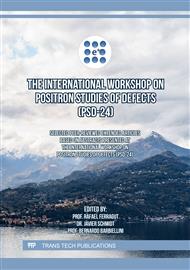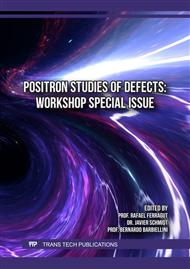[1]
D.B. Cassidy, Colloquium Experimental progress in positronium laser physics, Eur. Phys. J. D 72 (2018) 53
Google Scholar
[2]
T.J. Murphy and C.M. Surko, Positron trapping in an electrostatic well by inelastic collisions with nitrogen molecules, Phys. Rev. A 46 (1992) 5696
DOI: 10.1103/physreva.46.5696
Google Scholar
[3]
J. R. Danielson, D.H.E. Dubin, R.G. Greaves, and C.M. Surko, Plasma and trap-based techniques for science with positrons, Rev. Mod. Phys. 87 (2015) 247
DOI: 10.1103/revmodphys.87.247
Google Scholar
[4]
R.G. Greaves and C.M. Surko, Positron trapping and the creation of high-quality trap-based positron beams, Nucl. Instrum. Methods Phys. Res., Sect. B 192 (2002) 90
DOI: 10.1016/s0168-583x(02)00717-6
Google Scholar
[5]
S. Mariazzi, P. Bettotti, S. Larcheri, L. Toniutti, and R. S. Brusa, High positronium yield and emission into the vacuum from oxidized tunable nanochannels in silicon, Phys. Rev. B 81 (2010) 235418
DOI: 10.1103/physrevb.81.235418
Google Scholar
[6]
L. Liszkay, F. Guillemot, C. Corbel, J. P. Boilot, T. Gacoin, E. Barthel et al., Positron annihilation in latex-templated macroporous silica films: Pore size and ortho-positronium escape, New J. Phys. 14 (2012) 065009
DOI: 10.1088/1367-2630/14/6/065009
Google Scholar
[7]
S. Mariazzi, B. Rienäcker, R. Magrin Maffei, L. Povolo, S. Sharma, R. Caravita, L. Penasa, P. Bettotti, M. Doser, and R. S. Brusa, Forward emission of positronium from nanochanneled silicon membranes, Phys. Rev. B 105 (2022) 115422
DOI: 10.1103/physrevb.105.115422
Google Scholar
[8]
D.B. Cassidy, S.H. Deng, R.G. Greaves, and A.P. Mills, Accumulator for the production of intense positron pulses, Rev. Sci. Instrum. 77 (2006) 073106
DOI: 10.1063/1.2221509
Google Scholar
[9]
S. Aghion, C. Amsler, A. Ariga, T. Ariga, A. S. Belov, G. Bonomi et al., (AEgIS Collaboration), Positron bunching and electrostatic transport system for the production and emission of dense positronium clouds into vacuum, Nucl. Instrum. Methods Phys. Res., Sect. B 362 (2015) 86
Google Scholar
[10]
A. M. Alonso, S. D. Hogan, and D. B. Cassidy, Production of 23S1 positronium atoms by single- photon excitation in an electric field, Phys. Rev. A 95 (2017) 033408
Google Scholar
[11]
C. Amsler et al. (AEgIS Collaboration), Velocity-selected production of 23S metastable positronium, Phys. Rev. A 99 (2019) 033405
Google Scholar
[12]
D.B. Cassidy, T.H. Hisakado, H.W.K. Tom, and A. P. Mills, Jr., Efficient Production of Rydberg Positronium, Phys. Rev. Lett. 108 (2012) 043401
DOI: 10.1103/physrevlett.108.043401
Google Scholar
[13]
S. Aghion et al. (AEgIS Collaboration), Laser excitation of the n=3 level of positronium for antihydrogen production, Phys. Rev. A 94 (2016) 012507
Google Scholar
[14]
R.E. Sheldon, T.J. Babij, S.H. Reeder, S.D. Hogan, and D.B. Cassidy, Precision Microwave Spectroscopy of the Positronium 23S1→23P2 Interval, Phys. Rev. Lett. 131 (2023) 043001
DOI: 10.1103/physreva.107.042810
Google Scholar
[15]
C. Amsler et al. (AEḡIS Collaboration), Pulsed production of antihydrogen, Comm. Phys. 4 (2021) 19
Google Scholar
[16]
L. T. Glöggler et al. (AEḡIS Collaboration), Positronium Laser Cooling via the 13S−23P Transition with a Broadband Laser Pulse, Phys. Rev. Lett. 132 (2024) 083402
Google Scholar
[17]
K. Shu et al., Cooling positronium to ultralow velocities with a chirped laser pulse train, Nature 633 (2024) 793
Google Scholar
[18]
D. B. Cassidy and A. P. Mills, Jr., The production of molecular positronium, Nature 449 (2007) 195
Google Scholar
[19]
D. B. Cassidy and A. P. Mills, Jr., Interactions Between Positronium Atoms in Porous Silica, Phys. Rev. Lett., 100 (2008) 013401
DOI: 10.1103/physrevlett.100.013401
Google Scholar
[20]
P. M. Platzman and A.P. Mills, Jr., Possibilities for Bose condensation of positronium, Phys. Rev. B 49 (1994) 454
DOI: 10.1103/physrevb.49.454
Google Scholar
[21]
K. Shu, X. Fan, T. Yamazaki, T. Namba, S. Asai, K. Yoshioka, and M. Kuwata-Gonokami, Study on cooling of positronium for Bose-Einstein condensation, J. Phys. B: At. Mol. Opt. Phys. 49 (2016) 104001
DOI: 10.1088/0953-4075/49/10/104001
Google Scholar
[22]
B.C. Hiesmayr and P. Moskal, Genuine Multipartite Entanglement in the 3-Photon Decay of Positronium, Scientific Reports, 7 (2017) 15349
DOI: 10.1038/s41598-017-15356-y
Google Scholar
[23]
S.D. Bass, S. Mariazzi, P. Moskal, and E. Stępień, Colloquium: Positronium physics and biomedical applications, Rev. of Mod. Phys., 95 (2023) 1
DOI: 10.1103/revmodphys.95.021002
Google Scholar
[24]
A.P. Mills Jr, M. Leventhal, Can we measure the gravitational free fall of cold Rydberg state positronium?, Nucl. Instrum. Methods Phys. Res. B 192 (2002) 102
DOI: 10.1016/s0168-583x(02)00789-9
Google Scholar
[25]
M. Oberthaler, Anti-matter wave interferometry with positronium, Nucl. Instrum. Methods Phys. Res. B 192 (2002) 129
Google Scholar
[26]
S. Mariazzi, R. Caravita, M. Doser, G. Nebbia, and R.S. Brusa, Toward inertial sensing with a 23S positronium beam, Eur. Phys. J. D 74 (2020) 79
DOI: 10.1140/epjd/e2020-100585-8
Google Scholar
[27]
L. Povolo, S. Mariazzi, L. Penasa, R. Caravita , and R.S. Brusa, Generation of a bunched positron beam extracted nonadiabatically from a buffer-gas trap and focused in a free field region, Phys. Rev. Accel. Beams, 26 (2023) 051601
DOI: 10.1103/physrevaccelbeams.26.051601
Google Scholar
[28]
L. Povolo, S. Mariazzi, M. Bettonte, L. Penasa, R. Caravita, R.S. Brusa Systematic characterization of a Ne, Ar, Kr rare-gas moderated positron beam and spin polarization measurements, Nucl. Inst. and Meth. B 552 (2024) 165376
DOI: 10.1016/j.nimb.2024.165376
Google Scholar
[29]
S. Mariazzi, R. Caravita, L. Penasa, A. Cheahimi, R.C. Ferguson, S. Salandini, M. Bettonte, R.S. Brusa, New bunched positron beam at the AntiMatter Laboratory in Trento: planned quantum experiments with positronium, Acta Phys Pol A, 146 (2024) 5
DOI: 10.12693/aphyspola.146.674
Google Scholar
[30]
Y. Nagai, Y. Nagashima, J. Kim, Y. Itoh, T. Hyodo, Measurement of positron spin polarization by using the Doppler broadening method, Nucl. Inst. and Meth. B 171 (2000) 199
DOI: 10.1016/s0168-583x(00)00044-6
Google Scholar
[31]
J. Clarke, D. P. Van Der Werf, B. Griffiths, D. C. Beddows, M. Charlton, H. H. Telle, and P. R. Watkeys, Design and operation of a two-stage positron accumulator, Rev. Sci. Instrum. 77 (2006) 063302
DOI: 10.1063/1.2206561
Google Scholar
[32]
R. G. Greaves and J. M. Moxom, Compression of trapped positrons in a single particle regime by a rotating electric field, Phys. Plasmas 15 (2008) 072304
DOI: 10.1063/1.2956335
Google Scholar
[33]
J. P. Sullivan, J. Roberts, R. W. Weed, M. R. Went, D. S. Newman, and S. J. Buckman, A trap- based positron beamline for the study of materials, Meas. Sci. Technol. 21 (2010) 085702
DOI: 10.1088/0957-0233/21/8/085702
Google Scholar
[34]
D. A. Cooke, G. Barandun, S. Vergani, B. Brown, A. Rubbia, and P. Crivelli, Positron extraction to an electromagnetic field free region, J. Phys. B 49 (2016) 014001
DOI: 10.1088/0953-4075/49/1/014001
Google Scholar
[35]
S. Aghion et al. (AEgIS collaboration), Producing long-lived 23S positronium via 33P laser excitation in magnetic and electric fields, Phys. Rev. A 98 (2018) 013402
Google Scholar
[36]
M. Antonello et al. (AEgIS collaboration), Efficient 23S positronium production by stimulated decay from the 33P level, Phys. Rev. A 100 (2019) 063414
Google Scholar
[37]
M. Antonello et al., (AEgIS Collaboration), Rydberg-positronium velocity and self-ionization studies in a 1T magnetic field and cryogenic environment, Phys. Rev. A, 102 (2020) 013101
Google Scholar
[38]
O. Tokel, A. Turnalı, G. Makey, P. Elahi, T. Çolakoğlu, E. Ergeçen, Ö. Yavuz, R. Hübner, M. Z. Borra, I. Pavlov, A. Bek, R. Turan, D. Kesim, S. Tozburun, S. Ilday, F. Ö. Ilday, In-chip microstructures and photonic devices fabricated by nonlinear laser lithography deep inside silicon, Nature Photonics 11 (2017) 639
DOI: 10.1038/s41566-017-0004-4
Google Scholar
[39]
I.T. Sorokina, N. Tolstik, R. A. Richter, V. L. Kalashnikov, A. Rudenkov, and E. Sorokin, in the Proceedings of the VII International Symposium on Ultrafast Dynamics and Metastability 2022, 6 - 10 June, Crete, Greece, 84 (2022)
Google Scholar
[40]
M.X. Asaro, S. Herrera, M. Fuentes-Garcia, G.G. Cecchini, E.E. Membreno, R.G. Greaves, and A.P. Mills Jr, Conditions for obtaining positronium Bose–Einstein condensation in a micron-sized cavity, Eur. Phys. J. D., 76 (2022) 107
DOI: 10.1140/epjd/s10053-022-00427-1
Google Scholar
[41]
B.S. Cooper, J.-P. Boilot, C. Corbel, F. Guillemot, L. Gurung, L. Liszkay, and D. B. Cassidy, Annihilation of positronium atoms confined in mesoporous and macroporous SiO2 films, Phys. Rev. B, 97 (2018) 205302
DOI: 10.1103/physrevb.97.205302
Google Scholar
[42]
P. Sferlazzo, S. Berko, and K. F. Canter, Experimental support for physisorbed positronium at the surface of quartz. Phys. Rev. B 32 (1985) 6067
DOI: 10.1103/physrevb.32.6067
Google Scholar
[43]
R. Saniz, B. Barbiellini, P.M. Platzman, A.J. Freeman, Physisorption of positronium on quartz surfaces. Phys. Rev. Lett. 99 (2007) 096101
DOI: 10.1103/physrevlett.100.019902
Google Scholar
[44]
S. Mariazzi et al. (AEgIS Collaboration), High-yield thermalized positronium at room temperature emitted by morphologically tuned nanochanneled silicon targets, J. Phys. B: At. Mol. Opt. Phys. 54 (2021) 085004
DOI: 10.1088/1361-6455/abf6b6
Google Scholar
[45]
D.B. Cassidy, P. Crivelli, T.H. Hisakado, L. Liszkay, V.E. Meligne, P. Perez, H.W.K. Tom, A.P. Mills Jr., Positronium cooling in porous silica measured via Doppler spectroscopy. Phys. Rev. A 81 (2010) 012715
DOI: 10.1103/physreva.81.039904
Google Scholar
[46]
F. Guatieri, S. Mariazzi, C. Hugenschmidt, and R.S. Brusa, Classical modeling of positronium cooling in silicon nanochannel plates. Phys. Rev. B 106 (2022) 035418
DOI: 10.1103/physrevb.106.035418
Google Scholar
[47]
K. Shu, A. Ishida, T. Namba, S. Asai, N. Oshima, B.E. O'Rourke, and K. Ito, Observation of orthopositronium thermalization in silica aerogel at cryogenic temperatures. Phys. Rev. A 104 (2021) L050801
DOI: 10.1103/physreva.104.l050801
Google Scholar
[48]
D.B. Cassidy, S.H.M. Deng, R.G. Greaves, T. Maruo, N. Nishiyama, J. B. Snyder, H.K.M. Tanaka, and A. P. Mills, Jr., Experiments with a High-Density Positronium Gas, Phys. Rev. Lett. 95 (2005) 195006
DOI: 10.1103/physrevlett.95.195006
Google Scholar
[49]
B.C. Hiesmayr and P. Moskal, Witnessing Entanglement In Compton Scattering processes Via Mutually Unbiased Bases, Nature: Scientific Reports 9, (2019) 8166
DOI: 10.1038/s41598-019-44570-z
Google Scholar
[50]
S. Sharma et al. Feasibility studies for imaging e+e- annihilation with modular multi-strip detectors Nuclear Instruments and Methods in Physics Research A 1062 (2024) 169192
Google Scholar
[51]
A.D. Cronin, J. Schmiedmayer, D.E. Pritchard, Optics and interferometry with atoms and molecules, Rev. Mod. Phys. 81 (2009) 105
DOI: 10.1103/revmodphys.81.1051
Google Scholar
[52]
S. Mariazzi, R. Caravita, L. Glöggler, L. Povolo, L. Penasa, S. Sharma, P. Moskal and R.S. Brusa. Development of a Position-Sensitive Detector for Positronium Inertial Sensing Measurements, Acta Phys. Pol. A 142 (2022) 319
DOI: 10.12693/aphyspola.142.319
Google Scholar



